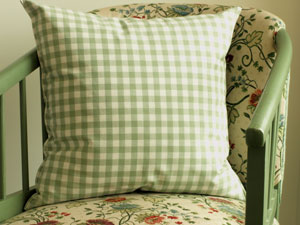 |
 |
|
THE IMPORTANCE OF SOFT-FURNISHINGS  Sometimes it seems obvious as to why we need soft-furnishings in our homes, clearly we all want our homes to look well and be comfortable. But when I was working through my source books one day I noticed that one of the introductions really spelled out the importance of them from an Interior Design and Style point of view. Leslie Geddes-Brown's introduction to 'The Soft Furnishings Source Book' is well worth a read so I've added it below.
"Take a plain cube of a room. Paint it a soft neutral grey, with matt-white ceiling, door and skirtings, and more of the same on the surrounds of the Georgian sash windows. The floor is made of softly polished wood. Here is the perfect space in which to experiment with what fabrics can do for a room. You want to be a minimalist? Add a pair of leather Wassily chairs designed by Marcel Breuer in 1925, a fireplace carved halfway up the wall (like Peter Mandelsonís), a set of Rupert Spira pots, and on the wall, Yoruba narrowstrip textile in ocre, terracotta, black and dark vermillion. Swedish? Put in a hardback settle with cabriole legs and cover it with square cushions in pink and grey stripes and checks. Put a round-bellied longcase clock against one wall and, at the window hand sheer white linens in front of blinds in a variation on the pink and grey cushions. For a French room, you could substitute gilded fauteuils and change the clock for a ormolu pillar timepiece on a bracket. Instead of the checks and stripes the chairs could be upholstered in rose-madder toile de Jouy and the windows given generous curtains of the same pictorial cotton backed by a checked toile de Nimes. An English Regency room would return to generous stripes - but unlike the Swedish cottons, these would be twilled silk in vibrant colours - black and ultramarine, citrus yellow and scarlet, purple and emerald green. The furniture, upholstered in shades of these colours, or embroidered with gros and petit point would be sabre-legged and brass-inlaid, perhaps including a chaise-longue with plain silk bolster. The walls would be densely hung with silk-embroidered pictures of flowers and butterflies, and the curtains swagged, tasselled and pelmeted with gilded arrowed poles, The same experimental cube could become a vernacular American parlour, where a traditional log-cabin quilt hangs on the wall behind a painted chest of drawers adorned with a single bird decoy. The curtains are a strong tweedy check in design, but made of cotton woven in browns and greys. Cushions on the hardback chairs are in one of the brown pictorial cottons - closely resembling toile, but showing a glorious scene from the Mexican-American war. Thereís a rag rug on the floor decorated with the Stars and Stripes. Itís tempting to go on, through Japanese- and Chinese-inspired rooms, to those instigated by India and Africa, by Russia and Italy. |

